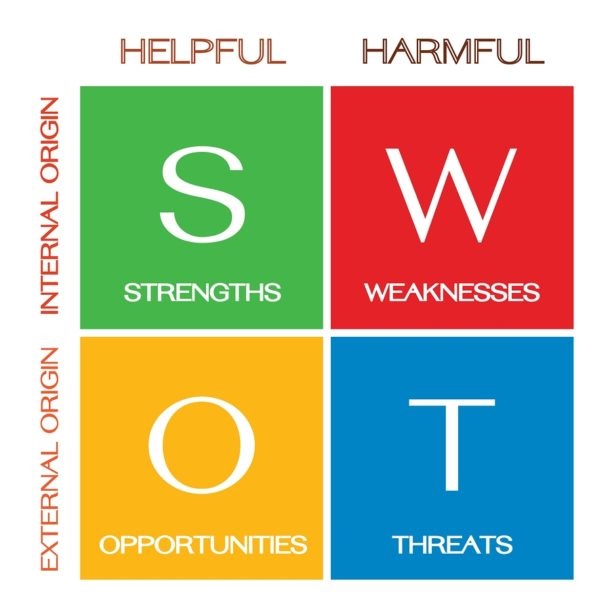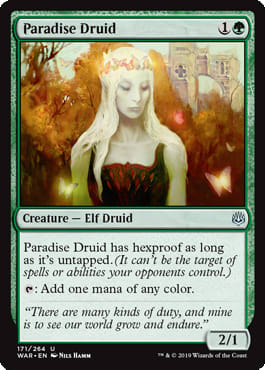A SWOT analysis is a helpful framework for thinking about... Almost anything?
SWOT stands for:
- Strengths
- Weaknesses
- Opportunities
- Threats
A SWOT can be represented via a 2x2 matrix; simply Strengths and Opportunities are "good" while Weaknesses and Threats are "bad". Strengths and Weaknesses are internally driven and Opportunities and Threats external.
Here is an easily visualization I ripped off of the nice people at Forbes.

No deck I've encountered in recent years more warranted a tip of the SWOT hat than Simic Mutate. Have you seen Simic Mutate?
Simic Mutate | IKO Standard | rastaf, MTGO Standard Preliminary 5/1/2020
- Companion (1)
- 1 Umori, the Collector
- Creatures (33)
- 3 Arboreal Grazer
- 3 End-Raze Forerunners
- 3 Gemrazer
- 4 Auspicious Starrix
- 4 Illuna, Apex of Wishes
- 4 Migratory Greathorn
- 4 Paradise Druid
- 4 Parcelbeast
- 4 Pollywog Symbiote
- Lands (27)
- 14 Forest
- 5 Island
- 2 Castle Garenbrig
- 2 Castle Vantress
- 4 Breeding Pool
- Sideboard (15)
- 1 Gemrazer
- 2 Agent of Treachery
- 3 Brazen Borrower
- 4 Destiny Spinner
- 1 Umori, the Collector
- 4 Voracious Hydra
Okay, okay... I suppose it is technically Temur Mutate on account of that Red pip on Illuna, Apex of Wishes; but you'll probably notice that while rastaf found room for a whopping twenty-seven lands... Not one of them can tap for a Red. This is kind of extraordinary given the presence of the basic land-hunting Migratory Greathorn.
How does this deck work?
Simic Mutate is a linear creature deck. It's got one copy of Umori, the Collector in the sideboard so is kind of locked in to one card type. You generally want to start on one of the inexpensive creatures for one or two mana, then get the ball rolling with one of the Mutate creatures. The best one is usually Migratory Greathorn, but you can get paid with almost anything.
A second or third turn Gemrazer will many times gobble a Lucky Clover right before upgrading your 0/3 into a fat 4/4.
And while it's not Migratory Greathorn, playing a first-turn Arboreal Grazer into a second turn Parcelbeast can be highly effective. No, a 2/4 isn't a 3/4, and you won't get the free attack while accelerating, but the upgrade into a mini Jayemdae Tome will win a surprising amount of games, if slowly.
Outside of the three cheap creatures, almost everything else in this deck Mutates. Illuna, Apex of Wishes and Auspicious Starrix can potentially cheat mana, which is great since End-Raze Forerunners costs so much. As such, you can play this deck somewhat like a combo deck, stacking Mutate onto Mutate until you hit End-Raze Forerunners and kill the opponent with a single large attack. You don't have to, but you can.
STRENGTHS (helpful, internal)
Contextually, Simic Mutate can be an outstanding solitaire deck. Given the popularity of Yorion and Keruga as Companions, you will often be up against decks that don't do anything meaningful before turn three. Sometimes the best thing they can do is use Teferi to bounce your Mutate creature; which, depending on how much mana acceleration you've gotten off, might just give you a sweet next turn.
Imagine you're going first and have the great Simic draw.
You open on Arboreal Grazer and drop Breeding Pool for free. Now on your second turn, you play your third land and Mutate Migratory Greathorn. This will give you the chance to attack for three with your former 0/3; but more importantly accelerate you to 5 mana on turn three.
Now here's the thing:
We said we had the good draw, right?
Castle Garenbrig won't let you cast Illuna, Apex of Wishes, but it will give you the chance to Mutate Auspicious Starrix. This will not only further upgrade your 0/3 3/4 into a 6/6, but you will get a second Rampant Growth trigger from your original Mutate; and then multiple from the Auspicious Starrix.
That draw was probably a little too good; it is pretty common to lace together Pollywog Symbiote discounts and multiple Mutate triggers on turn four, basically dumping half your deck onto the battlefield, up to and including End-Raze Forerunners.
The right sequences (which can often be random off the top of your deck) with multiple Symbiotes can put you in a position to perfect your hand while laying down multiple Greathorns for ![]() . You can get a ton of triggers, find a Starrix, and then get even more triggers.
. You can get a ton of triggers, find a Starrix, and then get even more triggers.
When you're on the play with this deck, it can potentially get draws that no one's average draw can possibly compete with.
WEAKNESSES (harmful, internal)
Simic doesn't have a lot of play. It's got powerful lines, but not much wiggle.
Back in the Odyssey days, a blue-green deck could play one enabler (a Wild Mongrel or Aquamoeba) and deploy one payoff or big guy, and limit the opponent's ability to counterplay for card advantage. If the opponent had a Wrath of God-type effect, they could get a two-for-one (provided it resolved) but then the not-yet-Simic player could follow up with 2 mana for another enabler, leaving up a ton of mana.
Recursive cards like Genesis would help blue-green to dig back; and those decks often had permission to combat mass removal or other big spells.
All this is basically the opposite with Simic Mutate.
One of the things I like least about this deck is how much it encourages you to stack a single creature with more and more cardboard. For instance an Arboreal Grazer into a Migratory Greathorn into a second Migratory Greathorn; the second 3/4 Beast doesn't get you any more power... But it is pretty sexy to pile multiple Mutates onto the same creature.
The problem with this is that one removal card can shut down your everything.
The biggest Weakness, though, is that Simic doesn't seem like a high skill deck to me. A Ramp-esque deck, you kind of have to draw your cards in the right order. You need to draw your Arboreal Grazer on the first turn, and your Symbiotes before your big Mutates. While the deck has a good amount of search and card advantage, you kind of have to play what you draw.
OPPORTUNITIES (helpful, external)
The deck's greatest Weakness is also, weirdly, a heck of an Opportunity.
If you're not that good... Simic Mutate can help you "luck" into not only wins, but overwhelming ones.
You can't really choose what you're going to draw with this deck, but sometimes your random distribution of cards will favorably overlap with the opponent's strategy.
You can lock certain opponents (or at least their key permanents) out with Gemrazer and any follow up Mutates. Witch's Oven? Fires of Invention? Sorry! The beauty of Gemrazer is that you don't need to draw lots of them, even if the opponent draws lots of artifacts and enchantments.
We said before that this deck can fall victim to spot removal; and that the deck doesn't have a lot of play. But do you know what is a really weird opportunity?
A turn two Paradise Druid followed by a Migratory Greathorn can start you down an interesting road. You can play more slowly; but also defy the opponent's planned interaction. So... Paradise Druid that gets bigger but never attacks; a mana acceleration creature That never taps... Until it's too late for the other guy.
THREATS (harmful, external)
The most exciting thing about Simic is that it can solitaire many opponents - little decks, decks that can't deal with 4 toughness, decks that don't play cards that cost less than three mana - but equipped decks can deal with it.
On the other hand...
If your opponent isn't scared of some big creatures... Simic is essentially just a Ramp creature deck.
You, though? You can't easily interact with the opponent's stuff; especially in Game 1. Lukka? Uh oh. You're probably going to lose on the spot to Lukka.
Utility creatures like Agent of Treachery aren't going anywhere (unless you trick them into blocking). You can get around this somewhat with the Brazen Borrowers in the sideboard, but you have precious few permanent solutions; any of which, it is worth saying, will dilute your linear.
KITCHEN SINK
I've blown a lot of wildcards on this deck, so even though these points don't cleanly fit into the SWOT paradigm, I figured it would be worth mentioning some common play patterns; hopefully they will help you win more.
- Illuna, Apex of Wishes and Auspicious Starrix are both 6/6. Ergo if you Mutate one onto the other, there is no compelling reason to put Illuna on top. It is generally better to put Auspicious Starrix on top, because flipping an incremental Illuna with either of their abilities isn't really up to you.
- The best draws tend to involve Arboreal Grazer; consider playing four copies.
- Be very mindful about your mana, especially with regards to deploying Umori or Pollywog Symbiote [first]. Example: If you have 6 mana and an Auspicious Starrix, think about whether it makes sense to play a Pollywog Symbiote first. If you already have Umori in play, the Symbiote will only cost
 ; and once the Symbiote is in play, it will pay you back thanks to the Umori discount.
; and once the Symbiote is in play, it will pay you back thanks to the Umori discount. - I TRIED TEMPLE OF MYSTERY (so you don't have to). It sure is cool to play one via Arboreal Grazer on the first turn, but drawing one in the midgame is really awkward. Not recommended.
LOVE
MIKE

























